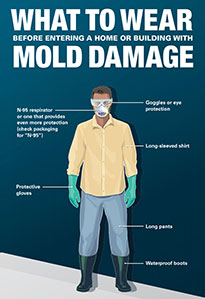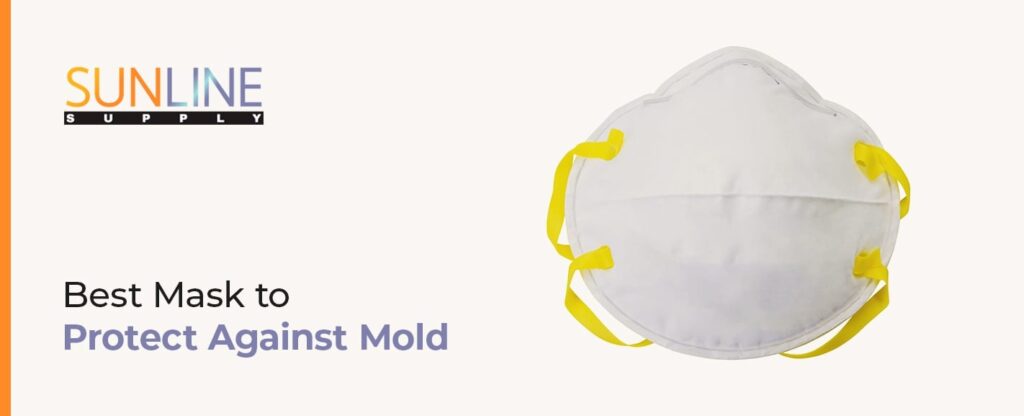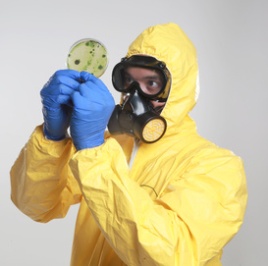When it comes to tackling mold in your home, one question that often arises is whether or not you need to wear a mask during the cleaning process. Mold can be a health hazard, releasing spores into the air that can cause respiratory issues. In this article, we’ll explore the importance of wearing a mask while cleaning mold and discuss the different types of masks that are recommended for this task. So, if you’re wondering about the best way to protect yourself while banishing mold from your living space, read on for some important information and tips.

Why is wearing a mask important?
Exposure to mold spores
When cleaning mold, wearing a mask is crucial to protect yourself from exposure to mold spores. Mold spores are tiny particles that can become airborne during the cleaning process. Inhaling these spores can lead to a range of health issues, especially for individuals with allergies or respiratory conditions.
Health risks associated with mold exposure
Exposure to mold can cause various health problems, including allergic reactions, respiratory issues, and even infections. Mold contains allergens and irritants that can trigger allergic reactions in sensitive individuals. It can also release toxic substances called mycotoxins, which can have severe health effects when inhaled or touched.
Types of masks for mold cleaning
N95 respirator mask
The N95 respirator mask is highly recommended for cleaning mold due to its effectiveness in filtering out airborne particles. It is designed to block at least 95% of very small particles, including mold spores. The N95 mask has a close facial fit and offers a secure seal, reducing the risk of inhaling mold spores.
Half-face or full-face respirator mask
For more extensive mold cleaning projects, a half-face or full-face respirator mask provides added protection. These masks cover the entire face and are equipped with special filters that can block not only mold spores but also harmful chemicals and gases, such as volatile organic compounds (VOCs).
Surgical mask
Surgical masks, while not as effective as N95 respirator masks, can still offer some level of protection when cleaning mold. They provide a physical barrier against large respiratory droplets and can help prevent the spread of mold spores. However, they do not provide a tight seal and may not filter out small mold particles effectively.
Cloth mask
Cloth masks are primarily designed for preventing the spread of respiratory droplets and are not specifically intended for mold cleaning. While they may offer some protection against mold spores, they are not as effective as N95 respirator masks or other specialized masks. It is recommended to use a more suitable option when dealing with mold.

Factors to consider when choosing a mask
Certification and filtration efficiency
When selecting a mask for mold cleaning, look for masks that are certified by reputable organizations, such as the National Institute for Occupational Safety and Health (NIOSH). This certification ensures that the mask meets specific performance standards. Additionally, it is essential to consider the filtration efficiency of the mask, particularly for smaller mold spores.
Fit and seal
A well-fitting mask is crucial for maximum protection against mold spores. Ensure that the mask covers both your nose and mouth adequately. There should be no gaps or leaks around the edges. Adjustable nose clips or moldable nose pieces can help achieve a secure fit and seal. Proper fit and seal are essential to prevent mold spores from entering the respiratory system.
Comfort and breathability
Comfort and breathability are also important factors to consider when choosing a mask for mold cleaning. Look for masks that are lightweight and breathable, as wearing a mask for an extended period can become uncomfortable. Adjustable straps and cushioned nose bridges can contribute to a more comfortable wearing experience.
Guidelines for wearing a mask when cleaning mold
Put on and take off the mask correctly
It is crucial to follow the proper procedures when putting on and taking off a mask to minimize the risk of contamination. Before wearing the mask, ensure that your hands are clean. Avoid touching the inside of the mask, as it may already be contaminated. Secure the mask over your nose and mouth, adjusting the straps for a snug fit. When removing the mask, handle it by the straps or ear loops, avoiding contact with the front portion. Dispose of disposable masks immediately or wash reusable masks thoroughly.
Proper mask disposal
Disposable masks should be discarded immediately after use. Mold spores may still be present on the mask, so it is essential to handle and dispose of them properly to prevent further contamination. Reusable masks should be washed regularly and thoroughly dried to eliminate any mold spores that may have accumulated.
Follow recommended cleaning practices
Cleaning contaminated areas should be done with caution. Prior to cleaning, it is advisable to mist the affected areas with water to minimize the dispersion of mold spores into the air. Use appropriate cleaning solutions specifically designed for mold removal. Clean surfaces thoroughly and scrub away visible mold growth. After cleaning, disinfect the area to kill any remaining mold spores. Remember to wear your mask throughout the cleaning process.

Additional protective equipment
Eye protection
In addition to wearing a mask, it is essential to protect your eyes from mold exposure. Mold spores can irritate the eyes, leading to redness, itchiness, and discomfort. Safety goggles or protective glasses with side shields can provide the necessary eye protection when cleaning mold.
Gloves
Wearing gloves is crucial when cleaning mold to prevent direct contact with mold spores or cleaning solutions. Disposable gloves made of latex, vinyl, or nitrile are recommended. Gloves should be in good condition and properly fitted to provide a barrier between your hands and potential contaminants.
Protective clothing
To further minimize the risk of mold spore contact, consider wearing protective clothing such as coveralls or long-sleeved shirts and pants. These garments should be made of a material that does not allow mold spores to penetrate through. It is essential to wash or dispose of the clothing properly after completing the mold cleaning task.
Precautions before cleaning mold
Identify the type of mold
Before cleaning mold, it is important to identify the type of mold present. Different types of mold may require different cleaning methods and precautions. If you are unsure about the type of mold or dealing with significant mold growth, it is recommended to consult a professional mold remediation specialist.
Ensure proper ventilation
Proper ventilation is crucial when cleaning mold to prevent the accumulation of mold spores in the air. Open windows and use fans to improve airflow during the cleaning process. This helps to reduce the concentration of airborne mold spores and ensures that they are not trapped indoors.
Reduce mold spore dispersion
To minimize the dispersion of mold spores during the cleaning process, mist the affected areas with water before cleaning. This helps to weigh down the mold spores and prevent them from becoming easily airborne. Additionally, avoid using high-pressure air or dry brushing techniques, as they can disturb the mold and release more spores into the air.

Steps for cleaning mold with a mask
Prepare the cleaning area
Before tackling the mold cleaning, set up a designated cleaning area. Remove any items or furniture that may obstruct the cleaning process. Use plastic sheets or tarps to cover and protect adjacent areas from potential mold spore contamination.
Wet mold and remove affected materials
Before cleaning visible mold growth, it is important to wet the area with water or a mold-specific cleaner. This helps to reduce the release of mold spores into the air. Carefully remove any affected materials, such as carpeting, drywall, or insulation, that cannot be effectively cleaned. Dispose of these materials properly to prevent further contamination.
Clean surfaces and disinfect
Using a mold-specific cleaner or a mixture of detergent and water, clean all surfaces affected by mold. Scrub away visible mold growth with a stiff brush or sponge, paying close attention to any porous materials. Once the cleaning is complete, disinfect the area using a mold-killing solution to eliminate any remaining mold spores.
Dispose of cleaning materials properly
After completing the mold cleaning process, dispose of all cleaning materials that may contain mold spores. This includes brushes, sponges, and rags used during the cleaning. Seal them in a plastic bag before discarding them in the appropriate waste bin. It is important to prevent the spread of mold spores during disposal.
When to seek professional help
Extensive mold growth
If you are dealing with extensive mold growth covering a large area (typically more than 10 square feet), it is best to seek professional help. Professionals have the necessary equipment, expertise, and safety protocols to effectively handle large-scale mold remediation projects.
Severe mold-related health symptoms
If you or anyone in your household experiences severe mold-related health symptoms, such as persistent coughing, difficulty breathing, or allergic reactions, it is advisable to consult a healthcare professional. They can assess your symptoms and provide appropriate medical advice.
Chronic respiratory conditions or weakened immune system
Individuals with pre-existing chronic respiratory conditions, such as asthma, or those with weakened immune systems should take extra precautions when dealing with mold. It is advisable to consult a healthcare professional or a mold remediation specialist to ensure a safe and appropriate approach to mold cleaning.

Preventing mold growth
Control indoor humidity
To prevent mold growth, it is important to control indoor humidity levels. Keep humidity levels below 60% to discourage mold growth. Use dehumidifiers or air conditioners in damp areas or during humid seasons. Ensure proper ventilation in bathrooms, kitchens, and other areas prone to moisture.
Fix leaks and water damage promptly
Promptly addressing any leaks or water damage is crucial in preventing mold growth. Fix plumbing leaks, roof leaks, or any sources of water intrusion as soon as they are discovered. Dry any wet materials or areas within 24-48 hours to minimize the chances of mold growth.
Proper ventilation and air circulation
Proper ventilation and air circulation help prevent the buildup of moisture and reduce the likelihood of mold growth. Use exhaust fans in bathrooms and kitchens to remove excess moisture. Open windows and use fans to improve airflow in enclosed spaces. Regularly clean and maintain HVAC systems to ensure adequate air exchange.
Conclusion
When cleaning mold, wearing a mask is vital to protect yourself from inhaling mold spores and experiencing health issues. Different types of masks offer varying levels of protection, with N95 respirator masks being the most effective for mold cleaning. It is essential to choose a mask with proper certification, filtration efficiency, fit, and seal for optimal protection.
Follow guidelines for putting on and taking off masks correctly, dispose of them properly, and follow recommended mold cleaning practices. Additional protective equipment, such as eye protection, gloves, and protective clothing, should be used to minimize exposure to mold spores.
Before cleaning mold, take precautions such as identifying the type of mold, ensuring proper ventilation, and reducing mold spore dispersion. Be thorough in the cleaning process, including wetting mold, removing affected materials, cleaning surfaces, and disinfecting. Dispose of all cleaning materials properly to prevent further contamination.
Seek professional help for extensive mold growth, severe mold-related health symptoms, or if you have chronic respiratory conditions or a weakened immune system. Prevent mold growth by controlling indoor humidity, promptly addressing leaks and water damage, and ensuring proper ventilation and air circulation in your home.
By following these guidelines, you can effectively clean mold while prioritizing your health and safety. Remember, taking preventive measures is crucial to minimize the risk of mold-related health problems in the future.